After the week end festival, it's time to go back to art again. What I'm going to write about today was a solo exhibition of Éva Barabás, a 83 years old artist lady, who's not selling her artworks anymore. The first reaction of any gallery visitor is to say Oh, too bad these artworks are not for sale, I had the same reaction too, but then comes the question, would you be able to afford them? Or are you willing to pay the price of these wonderful art creations? I would be.
Anyway, I was happy for being able to take these photos as once the exhibition is wrapped up, I doubt you will be able to see them again. So let's take these masterpieces one by one and allow me to tell you what they are about, or that I think they are about.
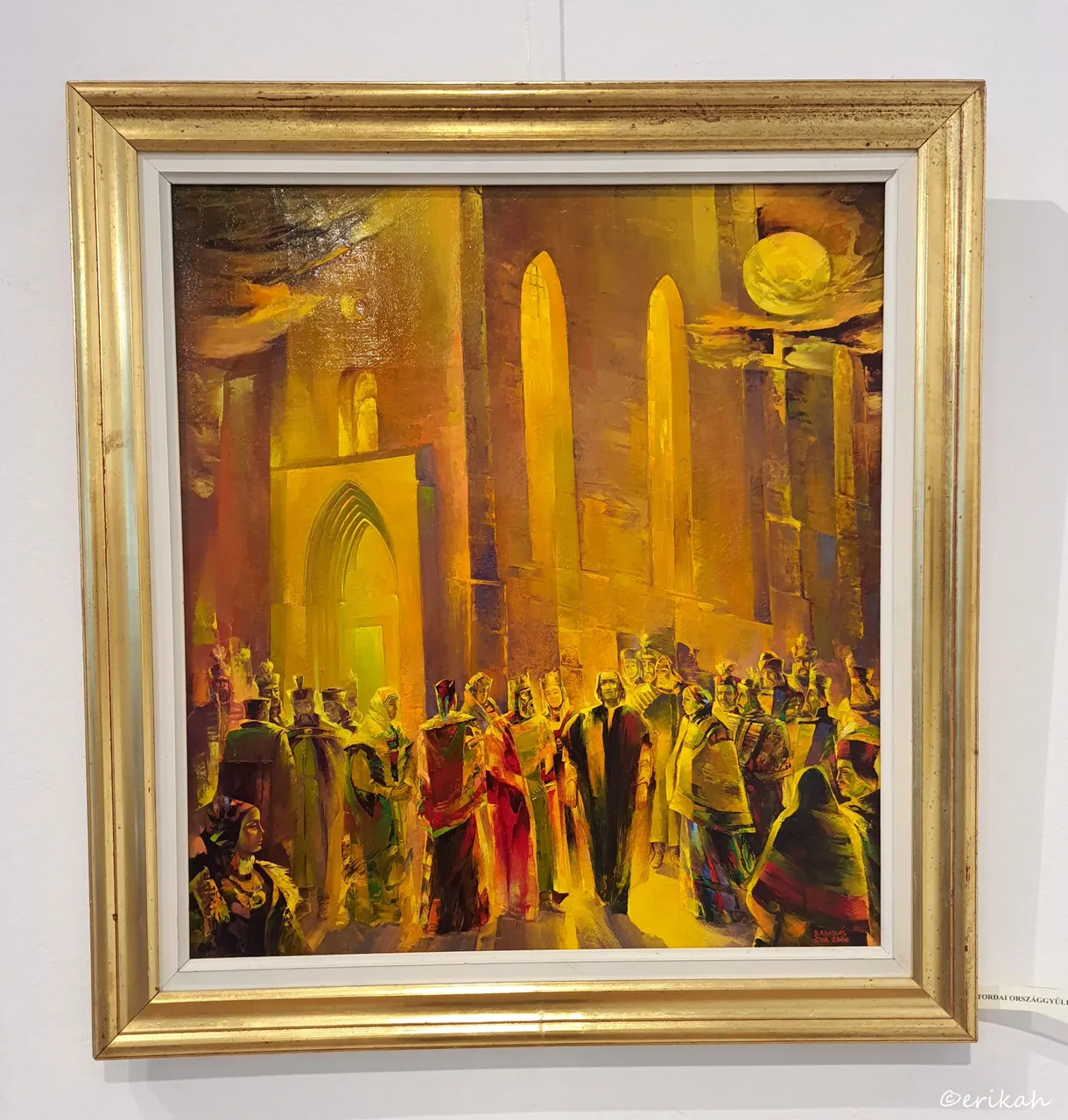
Edict of Torda
I've heard about the Parliament of Torda before and most likely we had this topic at history classes in school, but that was ages ago and to be honest, I can't remember what it was about exactly, so this was a great occasion to refresh my memories.
The Edict of Torda (Hungarian: tordai ediktum, Romanian: Edictul de la Turda, German: Edikt von Torda) was a decree that authorized local communities to freely elect their preachers in the Eastern Hungarian Kingdom of John Sigismund Zápolya. The delegates of the Three Nations of Transylvania – the Hungarian nobles, Transylvanian Saxons, and Székelys – adopted it at the request of the monarch's Antitrinitarian court preacher, Ferenc Dávid, in Torda (Romanian: Turda, German: Thorenburg) on 28 January 1568. Though it did not acknowledge an individual's right to religious freedom, in sanctioning the existence of a radical Christian religion in a European state, the decree was an unprecedented act of religious tolerance. source
What you see on the photo above is a historical scene, one of the meetings in which important political decisions were made. These meetings were mostly held in the church as back then the church was not separated from politics yet. What I love the most about the panting is the colors, the golden light spreading from inside the church, making the church the most powerful. Another detail that I need to mention is the proportions, that also shows the power of the church. Look at how tall the church is and how small the people are. This is reality however, not just the imagination of the artist. Back then the church was above all.
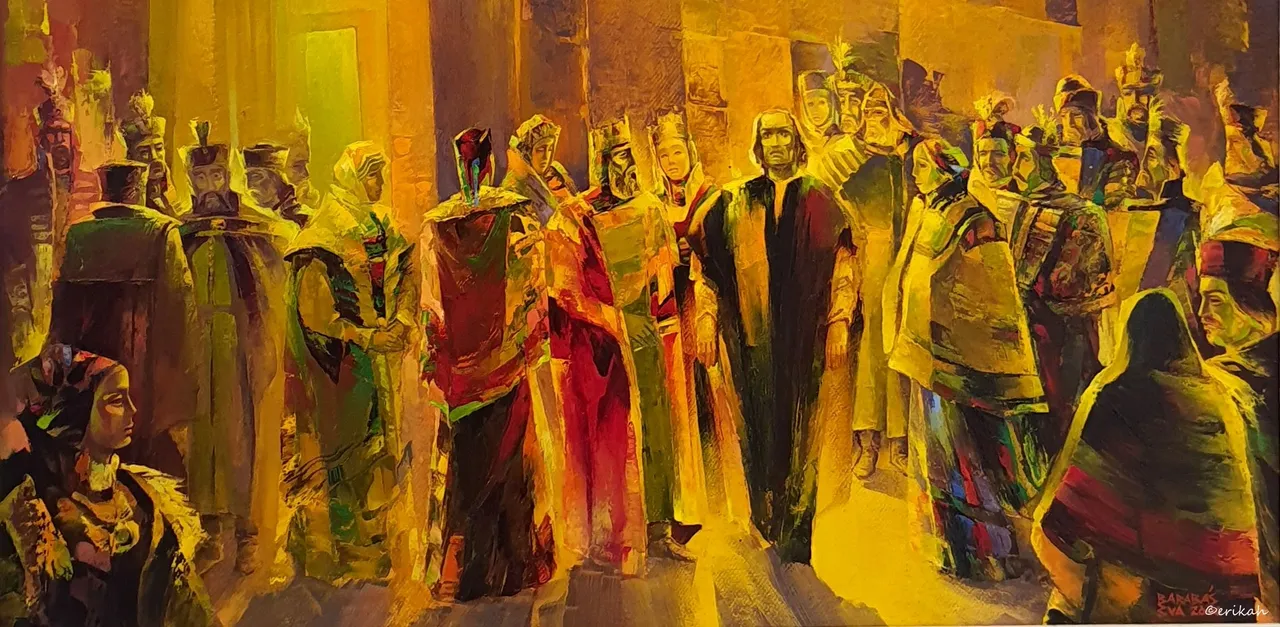
I wasn't sure if you can see the details, so here's a cropped part of the painting. Look at the faces and the clothes, see how extraordinary the execution is. Even though the topic is a bit heavy, I think I would love to have this one hanging on my office wall, reminding me where the whole thing started.
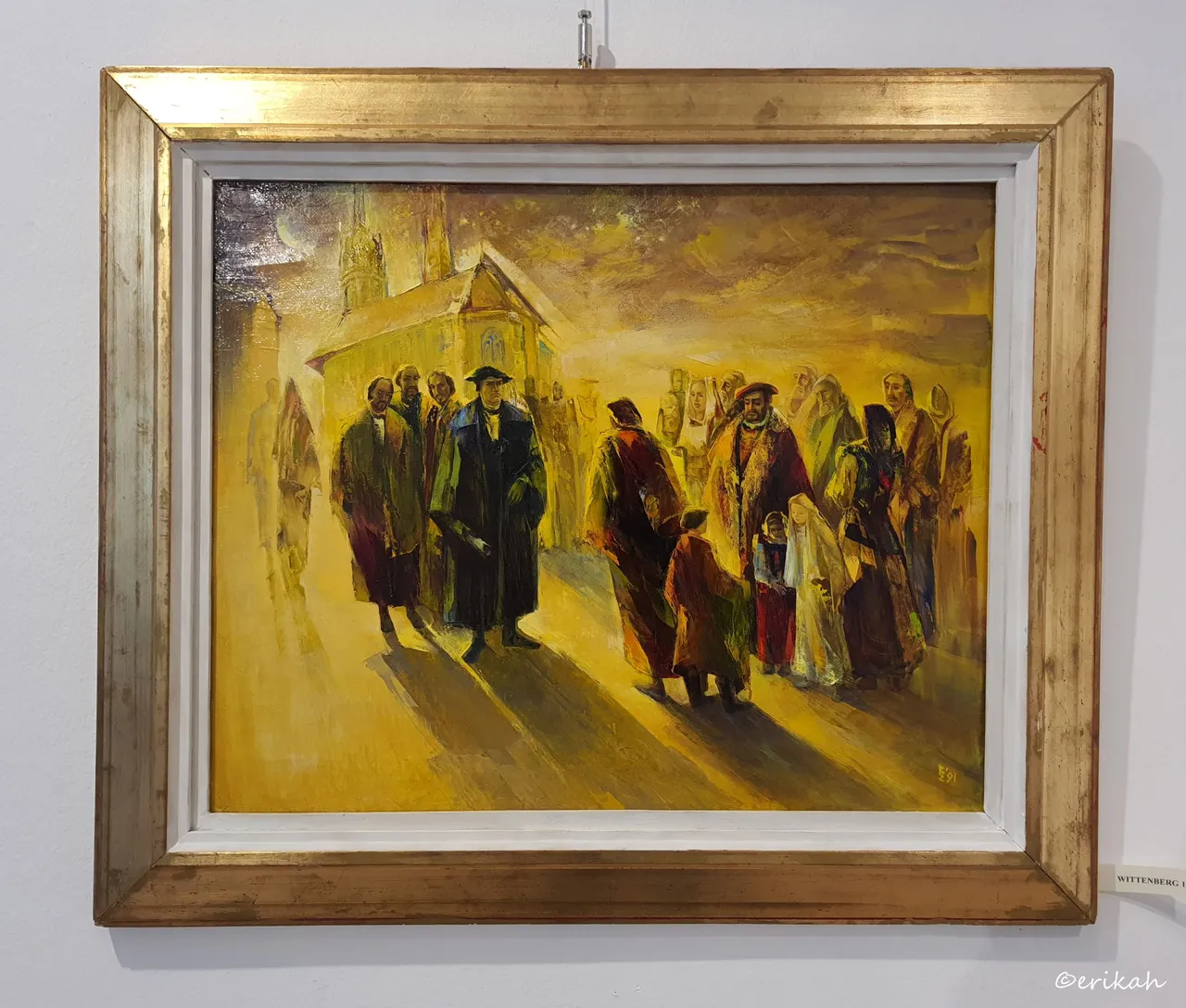
Wittenberg
I am wondering how many of you can make the connection, or know what this scene and Wittemberg have in common. But first let's see what we can see on the painting. There's the church in the background and again the golden light coming from the church. It's kind of the same style as the previous painting. To me, the golden light symbolizes the power of the church, it's a divine light. I may be wrong, who knows, but this is how I see it.
Now let's look at the characters in the painting. The main character is the man in the long black outfit in the left side of the painting. Judging by his outfit, to me it looks like a high ranking ecclesiastic with a rolled parchment in his hand. What does this has to do with Wittemberg? Martin Luther's Small Catechism was first printed in Wittemberg. I remember this from when I was a confirmand, many years ago. So those classes were not in vain after all it seems. If you Google Martin Luther's portraits, you'll see some resemblance between the character in the painting and him.
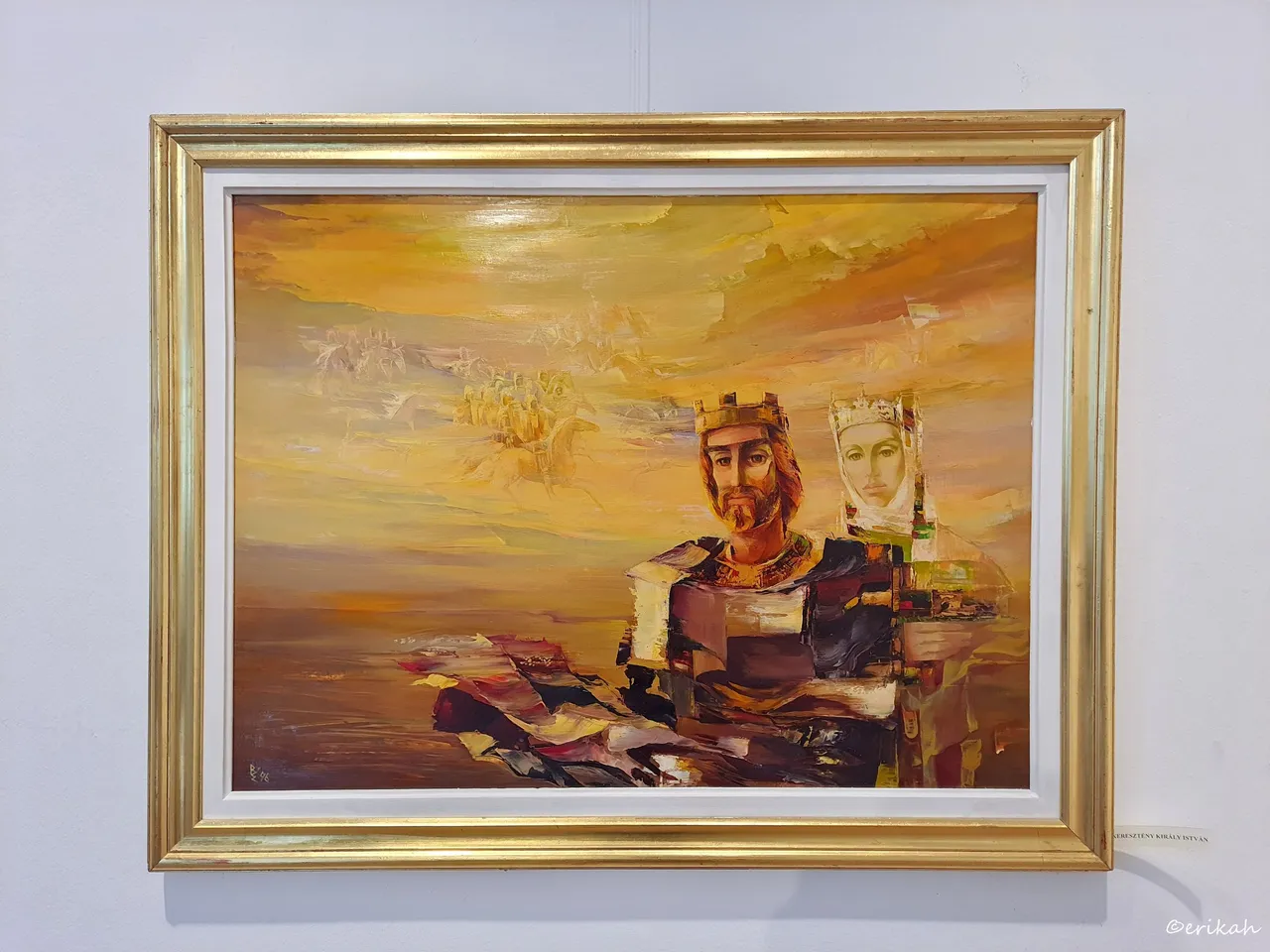
Christian King Stephen
Before I start to explain what you see on the painting (I'm not sure it's visible to everyone), let me tell you, this one is absolutely brilliant! How the artist chose to illustrate the story is fantastic.
First let's see who's Christian King Stephen.
Stephen I, also known as King Saint Stephen (Hungarian: Szent István király, 975 – 15 August 1038), was the last Grand Prince of the Hungarians between 997 and 1000 or 1001, and the first King of Hungary from 1000 or 1001, until his death in 1038. The year of his birth is uncertain, but many details of his life suggest that he was born in, or after, 975, in Esztergom. He was given the pagan name Vajk at birth, but the date of his baptism is unknown. He was the only son of Grand Prince Géza and his wife, Sarolt, who was descended from a prominent family of gyulas. Although both of his parents were baptized, Stephen was the first member of his family to become a devout Christian. He married Gisela of Bavaria, a scion of the imperial Ottonian dynasty. source
Look at the brush strokes on the clothes. Respecting the rule off third (not that it is needed in painting, but the artist did that in purpose, with a well defined goal), she placed the two main characters in the right corner, making the wife, Sarolt, a bit washed away as wives were meant to serve their husband and were not equal parts of the unity. We meet the golden background again, which just makes the Christian King Stephen more powerful.
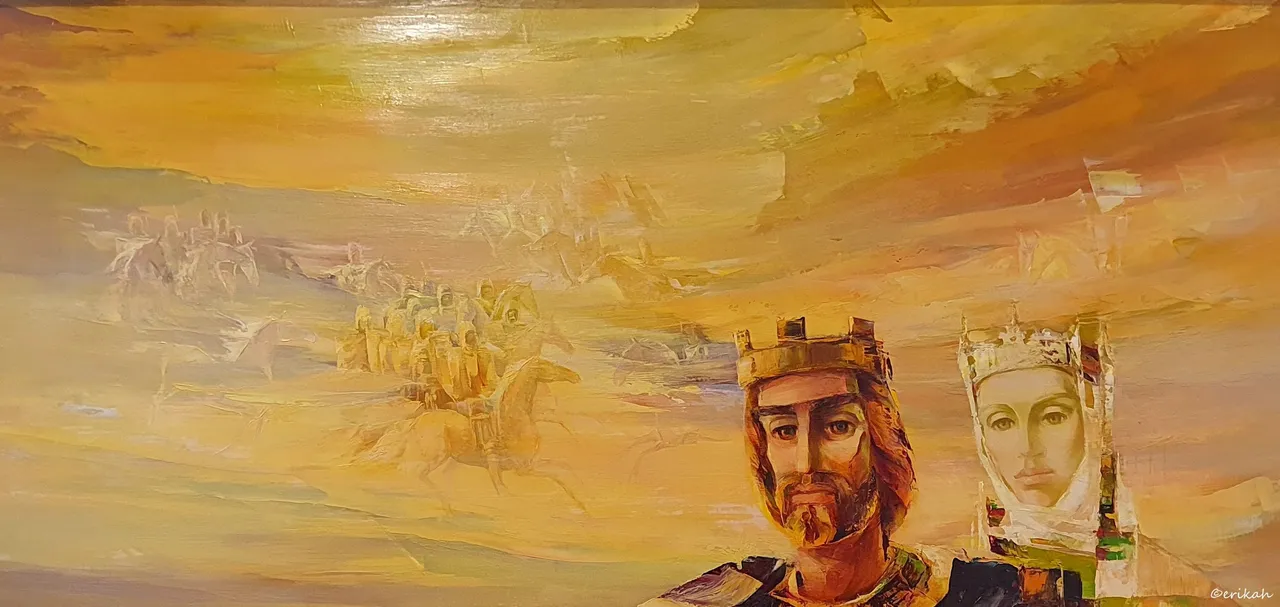
The structure of the composition is quite unique, I've never seen anything similar before. I had to crop the photo again to be able to highlight the details you may not see in the previous photo. Can you see the lackluster battle scenes? Why are those battle scenes so pale? To highlight the importance of the most powerful man, the king. It takes a lot of talent to create such a masterpiece as that's what this is.

Commemorating
Here, the golden light takes the center of the stage once again, highlighting where the most important action is happening. People commemorating someone's passing. The greenish blue color in the background just highlights the importance of the scene.
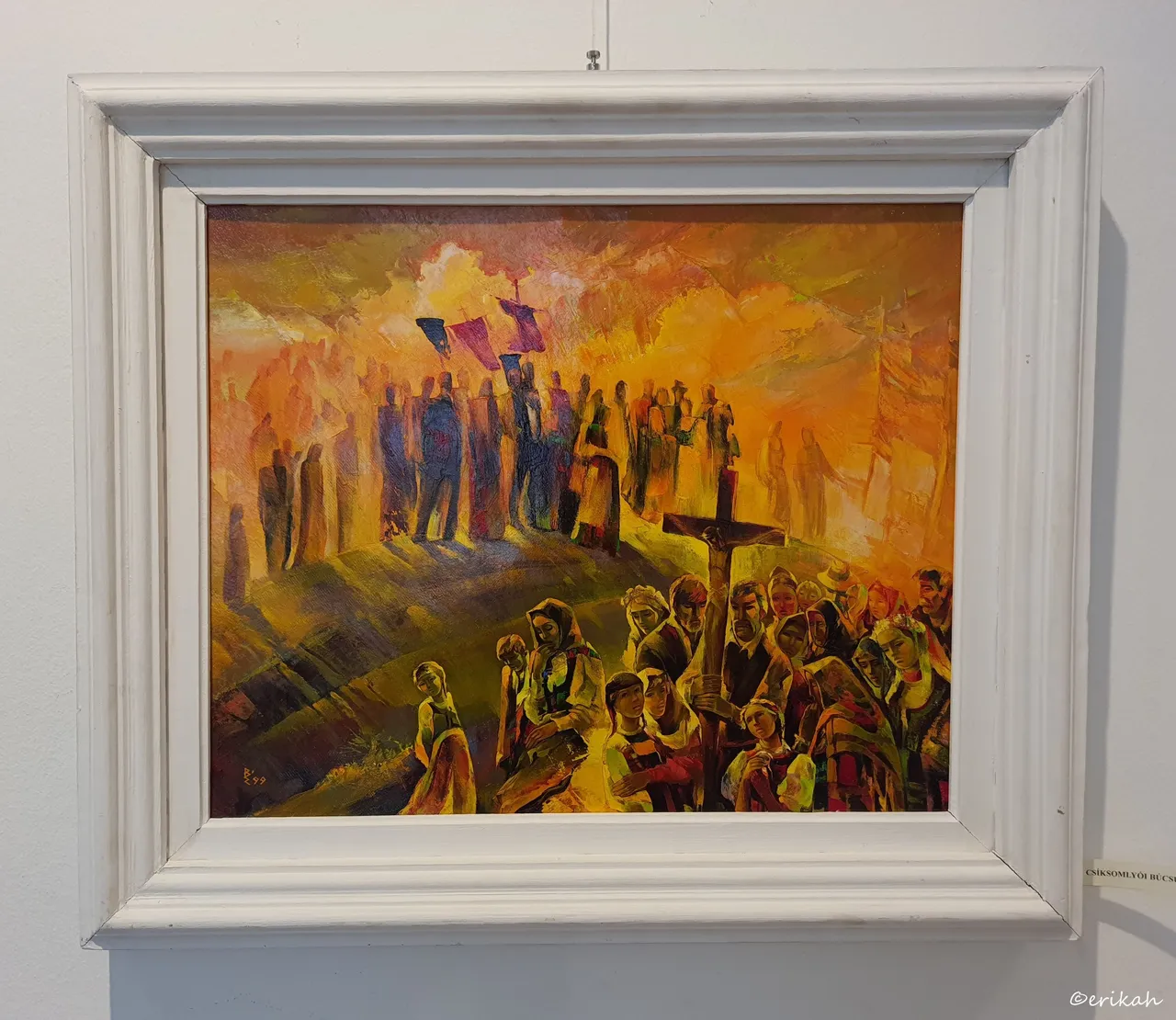
Csíksomlyó Pilgrimage
Most, if not all the works exhibited at this exhibition had a deep connection with Transylvania's history, or with the Transylvanian Hungarians' history. This is the fifth painting and most of them needed an explanation as anyone not familiar with this region's history would not understand. This is why maybe most of you won't feel the depth of the artworks. But let's see what this artwork means.
The Csíksomlyó Pilgrimage is a vow pilgrimage of the Székely people of medieval origin, which, starting in 1990, has now become the most significant Christian event in all of Hungary. The farewell held by the Hungarian Catholic and Christian believers every year at Pentecost, in the presence of hundreds of thousands of participants, in the church of Csíksomlyó in Transylvania and an open-air mass in the saddle between the nearby Kissomlyó and Nagysomlyó mountains.
The followers of the Roman Catholic Church in Csíksomlyó can receive a full absolution, because the believer who confesses his sins and shows repentance, who visits the place of worship in the state of grace of the sacrament of confession and listens to the mass there, also receives the complete remission of the punishments remaining after the forgiveness of his sins. source
The pilgrimage is an important event in Catholic's life and the procession is attended by tens of thousands coming from all over the world each year. They stay together, pray together in an indescribable silence. I'm not a Catholic, but it's on my list to visit the event.
The golden light is the main character again, just like in the previous paintings, somewhat placing the pilgrims in the shadow.
At the end of my post, I'm trying to put my thoughts on paper, but it's not easy. I have to admit that back in the gallery, these paintings did not make such a deep impression on me, meaning I admired the beauty of them and found them absolutely fantastic, but while writing the post, I had to document each historical event and meaning, to be able to explain to you the story behind each artwork and came to realize the deep meaning of each artwork. The artist had a vast knowledge of Transylvania's history and a deep connection with it. This post is to me like a walk back in history and thanks for walking with me. I'm considering myself officially lucky to have been able to attend this exhibition.

If you're a newbie, you may want to check out these guides:
- Communities Explained - Newbie Guide
- Cross Posting And Reposting Explained, Using PeakD
- Hive Is Not For Me
- How To Pump Your Reputation Fast - Newbie Guide
- Tips And Tricks & Useful Hive Tools For Newbies
- More Useful Tools On Hive - Newbie Guide
- Community List And Why It Is Important To Post In The Right Community
- Witnesses And Proposals Explained - Newbie Guide
- To Stake, Or Not To Stake - Newbie Guide
- Tags And Tagging - Newbie Guide
- Newbie Expectations And Reality
